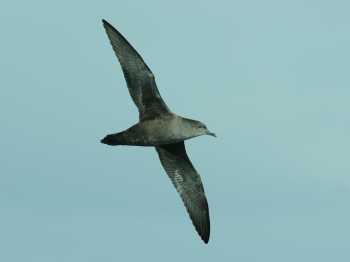
Sooty Shearwater, photograph by John Graham
Alejandro Simeone (Universidad Andres Bello, Departamento de Ciencias Biológicas, Santiago, Chile) and colleagues have published in the journal Biological Conservation on using beached seabirds in Chile to assess mortality from fishing fleets. Sooty Shearwater Ardenna grisea comprised 70% of all dead birds reported. Only 16 of the 19 281 birds in the study were positively identified as belonging to ACAP-listed species; ten of these were Pink-footed Shearwaters A. creatopus.
“The Chilean coast holds a high seabird diversity and also extensive fisheries that interact with birds producing bycatch. We used data on beached seabirds reported by news media to depict spatial and temporal patterns of fishery-related seabird mortality and correlated these data with the spatial and temporal fishing effort of the three main purse-seine fleets operating in south-central Chile (33 to 40°S). Between 2005 and 2019 we detected 97 mortality events reporting >19,000 beached seabirds attributed to bycatch. Mortality was recorded between 18 and 53° S (~3800 km of coastline), affecting 16 seabird species, with 90% concentrated between 33 and 40°S (800 km), exactly where purse-seine fleets operate. Sooty shearwater (Ardenna grisea) comprised 70% of all dead birds recorded. Magellanic penguins (Spheniscus magellanicus) and guanay cormorants (Phalacrocorax boungainvillii) were also affected. Mortality events of Sooty shearwaters was highest (P < 0.001) between February and May (54%) and October–November (36%), coinciding with the timing of the species migratory movements; shearwater mortality was particularly high at 36–37°S (50%) and 39–40°S (36%). Sooty shearwater mortality presented a very high spatial overlap (93%) and significant temporal correlation (0.64) with combined industrial and artisanal purse-seine fishing effort targeting on Peruvian anchovy (Engraulis ringens) and Araucanian herring (Strangomera bentincki). Our study shows when and where seabirds are more susceptible to mortality due to interactions with fisheries along the Chilean coast. This information could be used by authorities to regulate the fishing activity and focus conservation efforts to the most affected species at the appropriate spatial and temporal scales.”
With thanks to Janine Dunlop, Niven Librarian, FitzPatrick Institute, University of Cape Town.
Reference:
Simeone, A., Anguita, C., Daigre, M., Arce, P., Vega Guillermo, R., Luna-Jorquera, G., Portflitt-Toro, M., Suazo, C.G., Miranda-Urbina, D. & Ulloa, M. 2021. Spatial and temporal patterns of beached seabirds along the Chilean coast: linking mortalities with commercial fisheries. Biological Conservation doi.org/10.1016/j.biocon.2021.109026.
John Cooper, ACAP Information Officer, 23 March 2021

 English
English  Français
Français  Español
Español